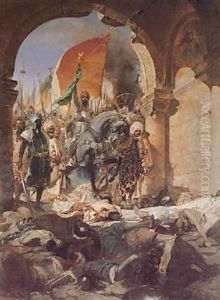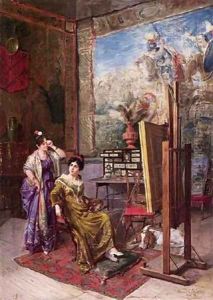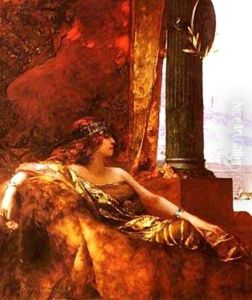Constant Benjamin Jean Joseph Paintings
Constant Benjamin Jean Joseph, known simply as Benjamin Constant, was a French painter born on June 10, 1860, in Paris. He is associated with the Orientalist movement, which was characterized by European artists depicting aspects of the Eastern world—North Africa, the Middle East, and Asia—often through a romanticized lens. Constant's works are notable for their rich color and dramatic lighting, which imbue his subjects with a sense of exoticism and sensuality.
Constant studied art at the École des Beaux-Arts in Toulouse before moving to Paris, where he worked under the tutelage of Émile Jean-Horace Vernet and then under Alexandre Cabanel at the École des Beaux-Arts in Paris. His education was traditional, emphasizing classical painting techniques and the mastery of historical and mythological subjects. He also spent time in the artist colony at the Villa Medici in Rome after winning the prestigious Prix de Rome in 1875, which was an important milestone for artists of his era.
Despite his classical training, Constant was captivated by the allure of the Orient. After traveling to Morocco in 1879, he began to produce works that reflected his fascination with the region. He depicted scenes of Moroccan life, harems, and marketplaces, which resonated with the French public's taste for the exotic. His paintings, such as 'The Harem,' 'The Pasha's Favourite,' and 'Evening on the Seashore,' show a blend of precise academic technique with a subject matter that spoke to the romanticized view of Eastern culture popular among European audiences at the time.
In addition to his Orientalist works, Constant also created portraits and historical paintings. He was a successful portraitist and received commissions to paint various notable figures of his time. His historical works often depicted grand, dramatic moments, and he was adept at capturing the essence of power and intrigue that characterized historical narratives.
Constant's reputation as an artist allowed him to take on several public commissions, including decorating various public buildings in Paris. He was also a respected teacher, with a significant influence on the next generation of painters. Among his positions, he taught at the Académie Julian in Paris, which was a private art school for painting and sculpture.
Benjamin Constant's work fell out of favor in the early 20th century as tastes changed and Orientalism came under critique for its often stereotypical portrayal of Eastern societies. However, in recent years, there has been a renewed interest in his work and that of other Orientalist artists for their historical value and artistry.
Constant's career was marked by national recognition and acclaim. He was awarded the Legion of Honor in 1884 and became a member of the Institut de France. He continued to paint and exhibit until his death on May 26, 1939, in Paris. Today, his works can be found in museums and private collections around the world, appreciated for their technical mastery and the window they provide into the 19th-century European imagination of the East.



